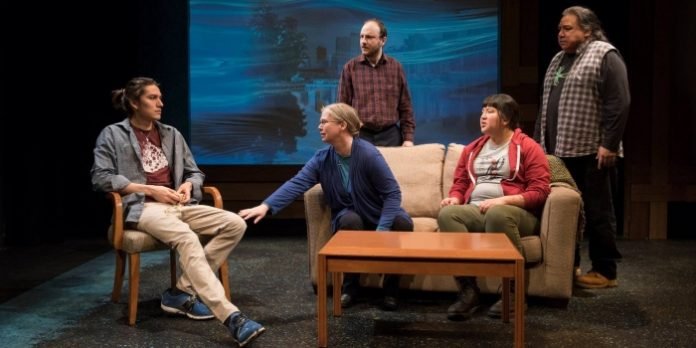We have seen šxʷʔam̓ət (home) before.
As with its 2011 production of Us and Them, Theatre for Living explores similar themes of systemic racism, cultural identity and appropriation in šxʷʔam̓ət (home). Where its 2011 production used the Stanley Cup riots as its backdrop, in this new iteration the examination of these issues is wrapped inside a quest for “a true and honourable” reconciliation.
As in 2011, the performance begins with a theatrical exploration of the issues. A young indigenous woman struggles with her identity and the loss of her language; an indigenous man struggles with alcohol; a white family tries desperately to hold onto their adopted Cree son.
None of this is new, but it does speak volumes to how little things have actually changed. As a society continuing to seek a path forward in an ongoing struggle towards truth and reconciliation, the fact we have made little headway is discomfiting.
Rather than simply presenting the issues though, Theatre for Living goes a step beyond the fourth wall to dissect and find potential solutions with the help of audience intervention.
Over the course of nearly two hours, Theatre for Living’s artistic and managing director David Diamond steps into the role of facilitator, engaging with the audience to further explore the issues presented in the play.
Replaying key scenes from the play, Diamond invites audience members to stop the action at any time to take the place of one of the actors. The goal is to potentially change the outcome of what we have already witnessed.
Diamond is a gentle facilitator, putting the audience at ease and making it a safe place for participation. On opening night he was able to coax a number of audience members on stage. While each approached the task differently, the outcome was essentially the same, with each audience member diffusing or potentially lessening the impact of the words and actions in the scenes.
As with the presentation of the issues themselves, there is little new ground broken. Much of the strength in these interventions came from the emotional connection audience members had to that particular moment in the play. It was a times quite powerful.
With a 2 ½ hour run time, šxʷʔam̓ət (home) is a huge investment on both sides of the proscenium. While there are theatrical elements, one has to wonder if the production might be better served in a more informal environment, rather than a traditional theatre. By placing the audience closer to the actors the effect would not only make it more comfortable for the interventions, it would have the potential to draw us more readily into the world we are collectively exploring.
šxʷʔam̓ət (home) is part of an ongoing dialogue. While it can be frustrating in the realization of how little has changed in recent years, I am reminded of Truth and Reconciliation Commissioner Marnie Wilson’s statement on the commission’s final report:
“We must be mindful that a process that will be as long and complicated as the reconciliation of seven generations of inequity will require stewardship, study and ongoing attention.”
The final word and a powerful call-to-action comes from Assembly of First Nations National Chief Perry Bellegarde in response to the Commission’s report:
“Rid yourselves of those racist attitudes, the discriminatory attitudes, those images of indigenous peoples as being substandard and pagan and savage. Rid yourself of those racial stereotypes of Indians and indigenous people being dumb and lazy and drunk and on welfare. Rid yourself of those things so new things can come in … respect for our languages, our customs and our traditions, that we are equally as important as human beings.”
šxʷʔam̓ət (home) created and performed by a mixed Indigenous and non-Indigenous cast and production team. Directed by David Diamond. A Theatre For Living production on stage at the Firehall Arts Centre (280 East Cordova St, Vancouver) until March 11. Visit https://theatreforliving.com for tickets and information.

